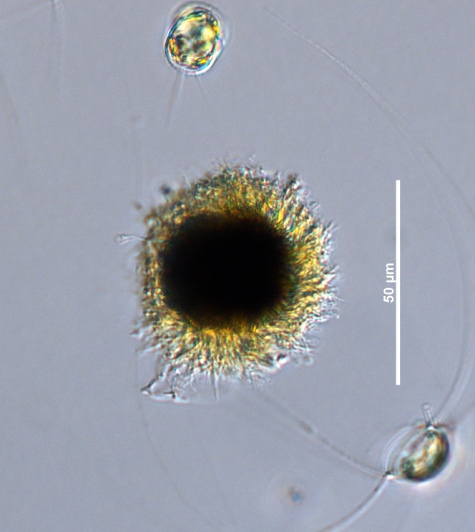



|
Synonym(s)
Cyclotrichium meunieri Powers 1932
Mesodinium rubrum Hamburger and Buddenbrock 1929
Halteria rubra Lohmann 1908
(Montagnes 2001)
*Still commonly referred to as Mesodinium rubrum.
Classification
(Guiry and Guiry 2012)
Lifestyle
Description
Anterior
The front. The part of the cell in the direction of movement. Opposite of posterior (HPP 2003).
anterior lobe and a smaller ClosePosterior
The back end of a cell. Opposite of anterior.
posterior lobe. A belt of tufted hairs (cilia) is present in the constriction. Numerous red chloroplasts of the symbiont are distributed throughout the cell, while the symbiont CloseNucleus
(plural: nuclei) In eukaryotic cells, a membrane-bound organelle that contains the cell's genetic information; the nucleus controls the activities of the cell by controlling gene expression.
nucleus is located centrally near the host nucleus. Cells are reddish in colour (Montagnes 2001).Lugol's iodine solution
A solution of elemental iodine and potassium iodide in water; it was first used in 1829 by French physician Jean Lugol as a disinfectant. Lugol's iodine can be used as fixative to preserve phytoplankton samples for visual analysis at a later time (Leakey et al. 1994).
Lugol's iodine solution this species normally is seen as a dark reddish-brown circular body surrounded by spiralling hairs (cilia).Measurements
Width: 20 - 75 μm
(Taylor et al. 1971, Montagnes 2001)
Similar species
Harmful effects
Habitat
Distribution
Cosmopolitan, often concentrated in coastal regions (Taylor et al. 1971).
Present throughout the year, with higher concentrations in spring and fall at most locations (Taylor et al. 1971).
Present in the Strait of Georgia throughout the year, with higher abundances and occasional localized blooms in late spring and early fall.
Growth conditions
Environmental Ranges
Temperature range (°C): As low as -1.594
Nitrate (μmol L-1): 6.894 - 28.528
Salinity: Not available
Oxygen (mL L-1): 6.447 - 7.869
Phosphate (μmol L-1): 0.630 - 2.085
Close
Silicic acid
A general term to describe chemical compounds containing silicon, oxygen and hydrogen with a general formula of [SiOx(OH)4-2x]n. Diatoms polymerize silicic acid into biogenic silica to form their frustules (Azam and Chisholm 1976).
Silicate (μmol L-1): 4.938 - 75.352(OBIS 2012, cited in EOL 2012)
Bloom characteristics
References
Encyclopedia of Life (EOL). 2012. Mesodinium rubrum. http://eol.org/pages/485165/overview. Accessed 25 Apr 2012.
Guiry, M. D. 2012. Myrionecta rubra Lohmann, 1908. http://www.marinespecies.org/aphia.php?p=taxdetails&id=292896. Accessed 25 Apr 2012.
Gustafson, D. E., Stoecker, D. K., Johnson, M. D., Van Heukelem, W. F. and Sneider, K. 2000. Cryptophyte algae are robbed of their organelles by the marine ciliate Mesodinium rubrum. Nature. 405: 1049-1052.
Montagnes, D. J. S. 2001. The Planktonic Ciliate Project Online - Myrionecta rubra. http://www.liv.ac.uk/ciliate/Datasheets/m_rubr.htm. Accessed 25 Apr 2012.
Ocean Biogeographic Information System (OBIS). 2012. Mesodinium rubrum. http://www.iobis.org/mapper/?taxon_id=643717. Accessed 25 Apr 2012.
Taylor, F. J. R., Blackbourn, D. J. and Blackbourn, J. 1971. The red-water ciliate Mesodinium rubrum and its 'incomplete symbionts': A review including new ultrastructural observations. Journal Fisheries Research Board of Canada. 28(3): 391-407.
